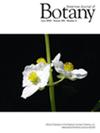Insect herbivory on woody broadleaf seedlings along a subtropical elevational gradient supports the resource concentration hypothesis
Abstract
Premise
Theories of plant–herbivore interactions hold that seedlings are more vulnerable to herbivory in warmer and more stable climates at lower elevations. Hypotheses of plant apparency, resource concentration, and resource availability have been proposed to explain variability in leaf herbivory. However, seasonal differences in the effects of these hypotheses on leaf herbivory on seedlings remain unclear.
Methods
We evaluated the three herbivory hypotheses by comparing the percentage and frequency of leaf herbivory in understory broadleaf seedlings in a subtropical forest in May (spring) and October (autumn) along an elevational gradient (290–1370 m a.s.l.). In total, we measured 2890 leaves across 696 seedlings belonging to 95 species and used beta regressions to test the effects of plant apparency (e.g., leaf area, seedling height), resource concentration (e.g., plant species diversity), and resource availability (e.g., canopy openness, soil available N and P) on leaf herbivory.
Results
Seedlings exhibited unimodal patterns of leaf herbivory along elevation, with drivers of leaf herbivory varying by the month. Variation in the frequency of leaf herbivory was best explained by the resource concentration hypothesis (e.g., plant species diversity) in both months, and herbivory was lower on seedlings in sites with higher plant diversity. Plant apparency hypothesis (e.g., leaf area, seedling height) was weakly supported only in spring, and the evidence for resource availability hypothesis (e.g., canopy openness, soil nutrients) was mixed.
Conclusions
This study supports the resource concentration hypothesis and reveals the importance of seasonal difference on understanding leaf herbivory patterns and the drivers of plant diversity in subtropical forests.

 求助内容:
求助内容: 应助结果提醒方式:
应助结果提醒方式:


